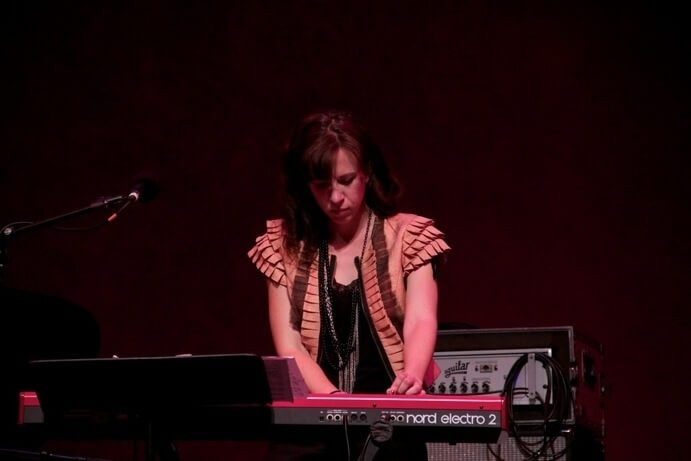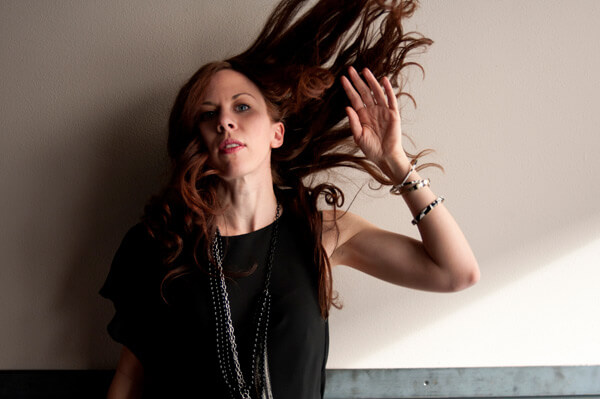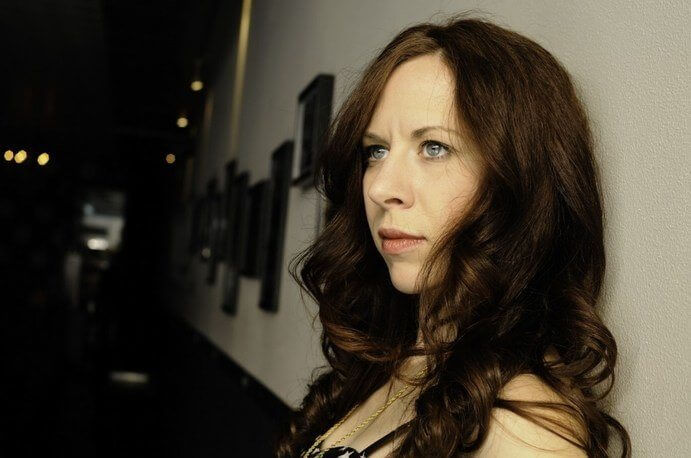The Composer Portrait Series at Miller Theatre offers a relatively unusual listening pleasure for contemporary music fans: concert-length immersion in the sound world of a living composer in a live-performance setting. On February 5, 2015 the Composer Portrait Series presented an evening focusing on the string works of Missy Mazzoli, including solo and ensemble pieces both with and without amplification and electronics.
I know Mazzoli’s music predominantly through pieces she has written for her band, Victoire, to which I listened obsessively over the few years that I collaborated with the group in creating live performance projections. When I think of her music, I think of jittery, gated electronics partnered with radiant melodies, of the elegiac beauty evoked by juxtaposing processed, gently degraded recordings of instruments or voices against the more robust presence of a live band. As I sat through the program assembled for her Composer Portrait, I found the concert works presented over the course of the evening bore the stamp of this same unmistakable voice.

Missy Mazzoli performing with Victoire– Photo by Kim Nowacki/Q2 Music.
Both the highlight and pitfall of the concert lay in the performances of three works for strings and electronics: A Thousand Tongues (2009), Tooth and Nail (2010), and Harp and Altar (2009). A Thousand Tongues, performed by cellist/vocalist Jody Redhage, partners sumptuous cello melodies, processed piano, and a setting of a text by Stephen Crane. Mazzoli’s attention to the electronics is paramount to the effect of the piece. She carefully processes the piano to lend it a brittle, ephemeral quality, and she uses gating, which imposes amplitude envelopes on a sound, to create rhythmic fields of pulsation out of the piano’s decay. The degradation of the piano recording layered against the fuller sound of the live cello and vocals gives the piece a melancholic, Sebaldian cast—sonic present overlaid against sonic past. The vocals come in a little more than halfway through the piece, a setting of a short text by Crane: “Yes, I have a thousand tongues,/And nine and ninety-nine lie./Though I strive to use the one,/It will make no melody at my will,/But is dead in my mouth.” One of the pleasures of this piece is that an inarguably sumptuous melody delivers lines about the impossibility of expression, about a tongue that will “make no melody.” Crane’s text is yet another incarnation of the inexpressibility topos—a mode of speech that declares it’s not possible to describe something or someone with truth—and yet here, paradoxically, the urgency of the text’s message comes across quite powerfully in the music. The electronics at the end of the piece recede into gorgeous decay, degenerating into staticky, glitchy loops as the cello slides quietly in the high end of its spectrum.
The piece is a showstopper. Unfortunately persistent problems with sound balance on all three of the electronic pieces held back the full effect; throughout the level on the electronic tracks verged towards the extremely demure. In Tooth and Nail, performed with charisma and exuberance by violist Nathan Schram, there were several false starts to get first the musician’s click and then the electronics going. And while Schram fully embodied the aggressive, frenetic energy of every figure he played, the electronics, even after they were started, were kept at a disproportionately low level. In Tooth and Nail the intensity of the interaction between the electronics and the live performer animates the piece, but in this performance the electronics were treated as background. On all three pieces the thin, even anemic presentation of the electronics made it seem as though the audience were listening to the pieces through a layer of saran wrap, preventing them from sounding as actualized and exciting as they actually are. Concert music tends to come with a bit of baggage in terms of how loudly venues will present it, but Mazzoli’s electroacoustic works straddle genres and would profit from a less tepid and uninspired treatment of their sound world.

Missy Mazzoli– Photo by Stephen Taylor
In an onstage discussion at the concert, Executive Director Melissa Smey asked Mazzoli to identify a throughline for the works programmed on the concert, and she responded by pinpointing the influence of Baroque music. And indeed, the frequent pulsation and dynamic contrast in her works does reveal a contemporary refraction of the Baroque—not a mannered return to the era as a vehicle to solve compositional problems, but rather an ontological one that results in a complex and exuberant musical surface.
The piece that pointed most directly to the Baroque era was Dissolve, O My Heart for solo violin (2010), a contemporary response to the Chaconne of Bach’s Partita in d-minor. It reserves the rich textures and insistence of the Chaconne, as well as its emotional range, by turns melancholy, exuberant, or both. Beginning with the iconic opening chord of the Chaconne, the piece immediately begins moving through related but divergent harmonies, giving the effect of hearing the chord refracted through a prism.
Another program highlight was the opening work, Death Valley Junction (2010), played with authority by the Mivos Quartet. A programmatic evocation of an isolated town on the border of California and Nevada, the piece is an homage to one of Death Valley Junction’s three inhabitants, Marta Becket, who repaired the town’s opera house and proceeded to perform one-woman shows there over a forty-year period. Mazzoli has metabolized her source inspiration; the quartet evokes wild, unpopulated spaces with eery slides and spare, lonely textures, along with broad sections of moto perpetuo, which have a clamorous, raw feel, evoking the grit and determination of Marta Becket.
If the idea of a “Composer Portrait” is to create a likeness of a composer in sound, this program succeeded, with a group of works that was diverse enough to hold interest, yet consistent enough to reveal a young composer who has developed an unmistakable sonic identity.























